Industrial Air Compressor Market Size
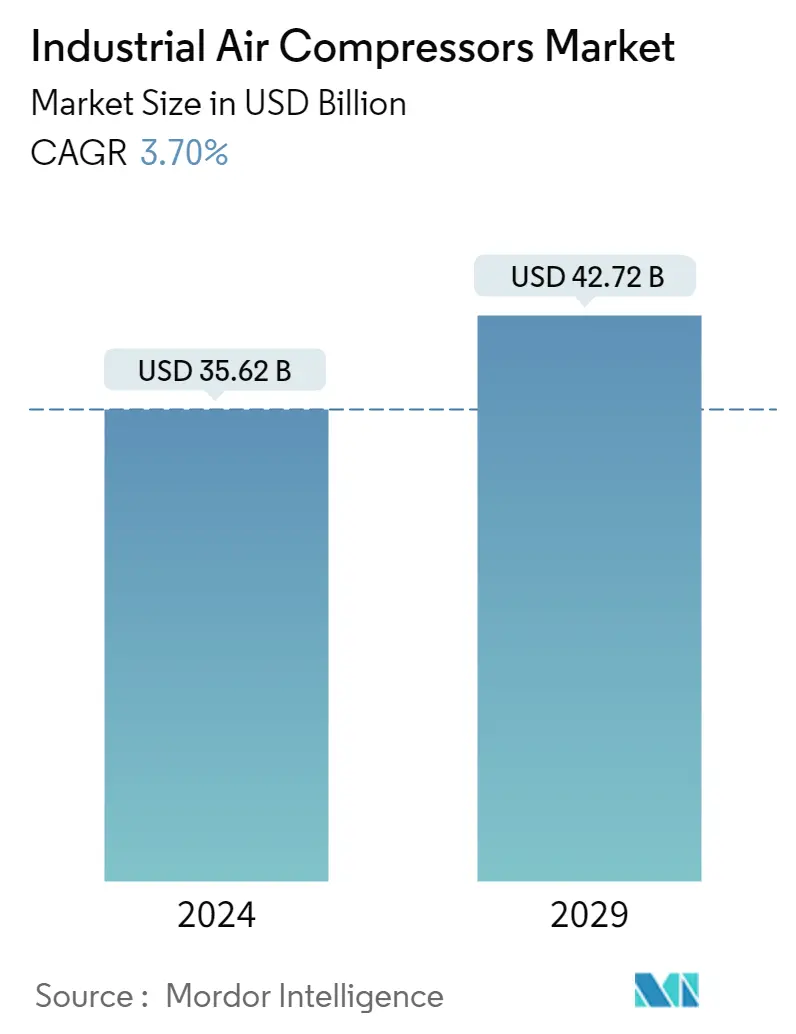
| Study Period | 2019 - 2029 |
| Market Size (2024) | USD 35.62 Billion |
| Market Size (2029) | USD 42.72 Billion |
| CAGR (2024 - 2029) | 3.70 % |
| Fastest Growing Market | Asia Pacific |
| Largest Market | Asia Pacific |
Major Players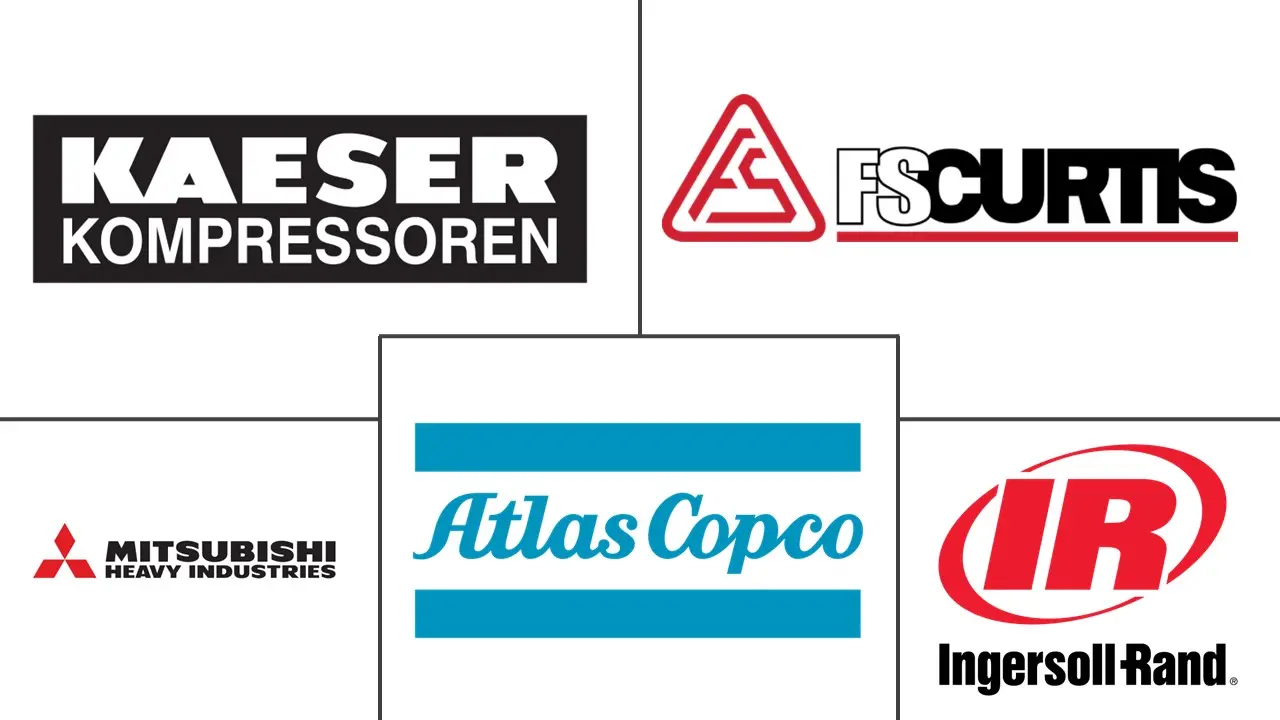
*Disclaimer: Major Players sorted in no particular order |
Industrial Air Compressor Market Analysis
The Industrial Air Compressors Market size is estimated at USD 35.62 billion in 2024, and is expected to reach USD 42.72 billion by 2029, growing at a CAGR of 3.70% during the forecast period (2024-2029).
Increases in the oil and gas, petrochemical, transportation, agricultural, and automotive industries globally, as well as increased government support for developing industrial compressor technology, are some important reasons that significantly speed up market expansion.
- A wide range of businesses worldwide generally uses air compressors to deliver compressed air to power complex industrial processes. Heavy-duty industrial air compressors are developed to provide higher pressure levels, as they rely on high horsepower motors and heavy-duty components. In agricultural facilities, these are used to spray crops and ventilate silos, power pneumatic machinery in the manufacturing industries, and oil and gas operations, among others.
- Air compressors have an advantage over electric power and hydraulic power due to their capability to offer flexibility, safety, and low-maintenance cost. Air compressors require fewer moving parts than electrical and hydraulic power systems. However, air compressors need special treatment for the supplied air, as any contamination in the air can damage the supply pipes, leading to corrosion in leakages, ultimately resulting in power output.
- The companies in the market are also continuously investing in developing energy-efficient air compressors. For instance, Atlas Copco mentioned that it is focusing on developing oil-injected technology for offering energy-saving compressor solutions by integrating intelligent control and monitoring systems.
- Moreover, these compressors are used based on the application and location of the compressor to be installed. For instance, reciprocating-type compressors must be installed with flywheels on the side of the wall and an enclosed belt guard, and they need spaces on the sides for maintenance. In the case of the rotary type, the compressors need to be installed so that their inlet grids and ventilation fan may not recirculate the cooling air to the compressor.
- These air compressors used in industries require special cooling units to dispense the heat generated, adding to the companies' initial setup cost. Hence, the companies are looking forward to better-performance compressors to cut down on energy and maintenance costs.
- Apart from these applications, air compressors are also used for petroleum refining, petrochemical synthesis, pipeline transportation, and gas injection. The increasing expansion of oil and gas exploration and investment in the industry are the major factors driving the market growth.
- According to Ingersoll Rand, only 10% to 20% of the energy input to the compressed air systems reaches the point of use, whereas the rest of the energy gets wasted in heat or leaks. This may account for millions of dollars for organizations having large operations.
- Air compressor installation and maintenance costs are very high. Due to the upkeep of intricate monitoring and control systems for various air compressors, the price keeps increasing. This is anticipated to slow market expansion in the near future.
- However, due to the outbreak of COVID-19, Chinese vendors closed their factories, temporarily suspending production facilities. Since the number of COVID-19 cases has reduced in China, the vendors having manufacturing plants based in the region have increased component prices by nearly 2-3%, owing to a shortage of supplies due to factory shutdown. Therefore, this has impacted the entire supply chain from China. The COVID-19 spread has also driven innovations in the compressors segment, with vendors ramping up their production to meet the sudden demand increase.
Industrial Air Compressor Market Trends
This section covers the major market trends shaping the Industrial Air Compressors Market according to our research experts:
Rotary Air compressors to Hold Significant Share
- Rotary air compressors, also known as rotary screw air compressors, are a positive displacement compression system and are adopted above other compressors due to several advantages it offers, like a significant reduction in weight and easier maintenance (owing to the availability of simplified maintenance procedures), lesser overall oil consumption, proven reliability in harsh environments, and less heat generation.
- Rotary air compressors are mainly preferred by users requiring constant pressure for usually extended periods. It is used in various industrial settings for applications such as material handling, spray painting, and use with machine tools. In addition, multiple industries, such as manufacturing, food, beverage, and pharmaceutical, are deploying oil-free air compressors to optimize their processes and reduce costs in production.
- Moreover, Oil-injected air compressors are generally used by users requiring large volumes of medium-pressure air. For instance, No Sabe Fallar, SA de CV, the Mexican subsidiary of the global BIC Group, manufactures safe, reliable BIC products and uses a group of GA-type compressors, an energy-saving ES control system, and the AirConnect Visualization System. The oil-lubricated air compressor provides equal levels of reliability and substantially drives down costs through the smart use of energy.
- Oil-free rotary screw models are used in production, industrial, or medical applications to disable oil from entering the airflow, like food packaging or medical oxygen. Oil-free rotary air compressors are expensive as they require two compression stages to reach the same pressures as an oil-injected rotary system.
- Industrial air compressors play a significant role in the modern oil and gas industry for large and small operations. For instance, according to Q Air-California, 95% of petroleum gas is processed through compression before transporting in a pipeline.
- The oil and gas industry demands sustainable and reliable compressed air equipment. Various downstream oil & gas companies are impacted due to a slowdown in demand for petrochemical and refined products due to the COVID-19 pandemic. Lower refining margins lead to lower profits for downstream oil companies such as BPCL, HPCL, IOCL, and RIL. In contrast, upstream companies such as Oil India and ONGC are impacted due to less gas and oil demand growth due to a reduction in travel and industrial activities, thereby affecting industrial air compressors in the oil and gas industry.
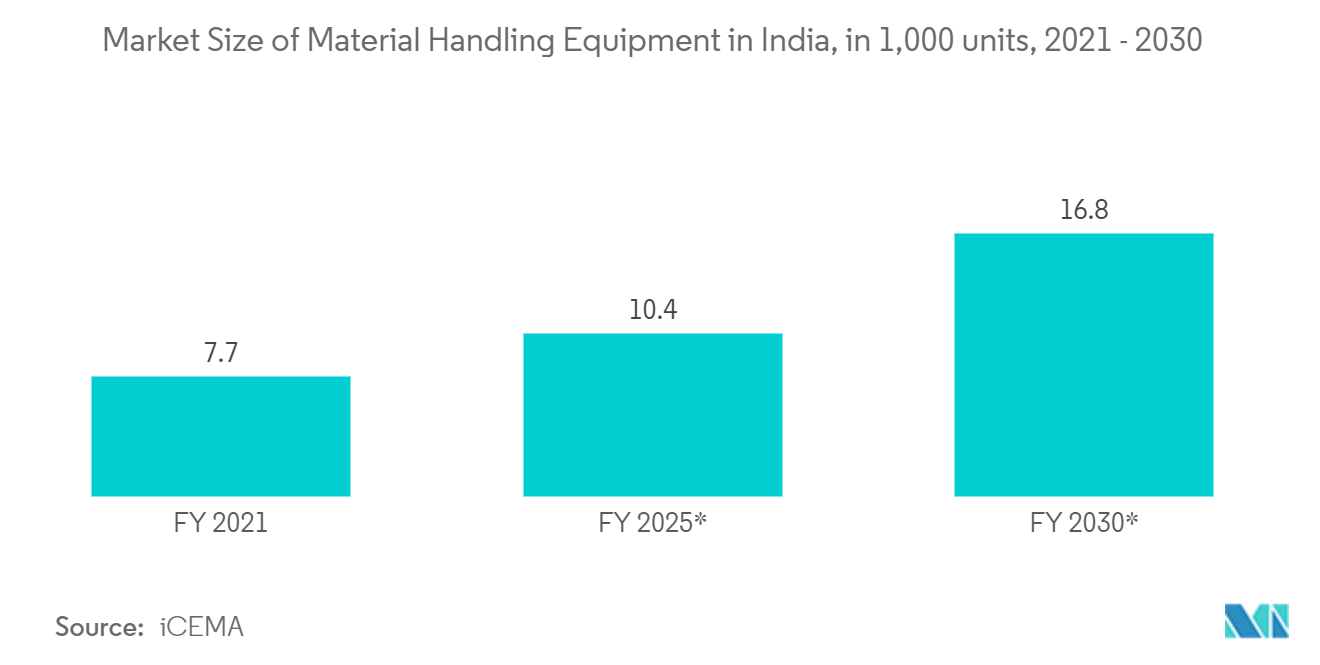
Asia-Pacific to Account for a Significant Market Share
- China is expected to be one of the largest markets in the Asia-Pacific region and globally for industrial air compressors in terms of production and consumption. The primary factor for the country's dominance is the presence of several air compressor manufacturers in the country, such as Zhejiang Kaishan Compressor Co. Ltd, VMAC Company, DHH Compressor Jiangsu Co. Ltd, and DENAIR Energy Saving Technology (Shanghai) PLC, among others.
- The other factors that are highly responsible for the growth in the region are the Government regulations and policies expected to boost the market further, increasing air compressors' adoption for energy efficiency. For instance, The Energy Policy and Conservation Act prescribed energy conservation standards for various consumer products and commercial and industrial equipment, including air compressors.
- Moreover, China has become attractive by developing indigenous industries and subsequent acceleration in exports, the introduction of stringent standards, and rapid urbanization. China has a very high industrial production rate and ranks among the 28 fastest-growing nations. These factors act as drivers for adopting industrial air compressors in manufacturing facilities in the county.
- In addition, Several investments are being planned to aid the quality of growth in the region, address environmental concerns, and reduce overcapacity, for the same. It has a leading presence in several end-user industries, such as food and beverage, electronics, construction, and mining.
- Despite enormous development in alternative energy sources, oil and oil-based products' demand increases with the rising global population, predominantly in China, India, and Japan. Consequently, to keep up with the demand, industrial air and gas compressors have become invaluable for ensuring the appropriate pressure levels for these operations, with innovations focused on lower energy requirements, increased speed, and a more remarkable ability to withstand harsh drilling environments to maintain a competitive edge.
- Furthermore, India is expected to become the fifth-largest manufacturing country globally by the end of 2021. Manufacturing giants, such as Siemens, GE, and Boeing, have either set up or are setting up new manufacturing plants in India as part of their expansion strategy. These trends indicate the growth in the country's adoption of industrial air compressors.
- According to the recent forecast of OPEC, for the first time in current projections, India is expected to stand as the single most significant contributor to future energy demand, followed by China and other countries, standing in the product range of oil from 22 to 23 mboe/d. Establishing these refineries and storage in seashore areas and areas of harsh climatic conditions is expected to push industrial air compressor demand in the country.
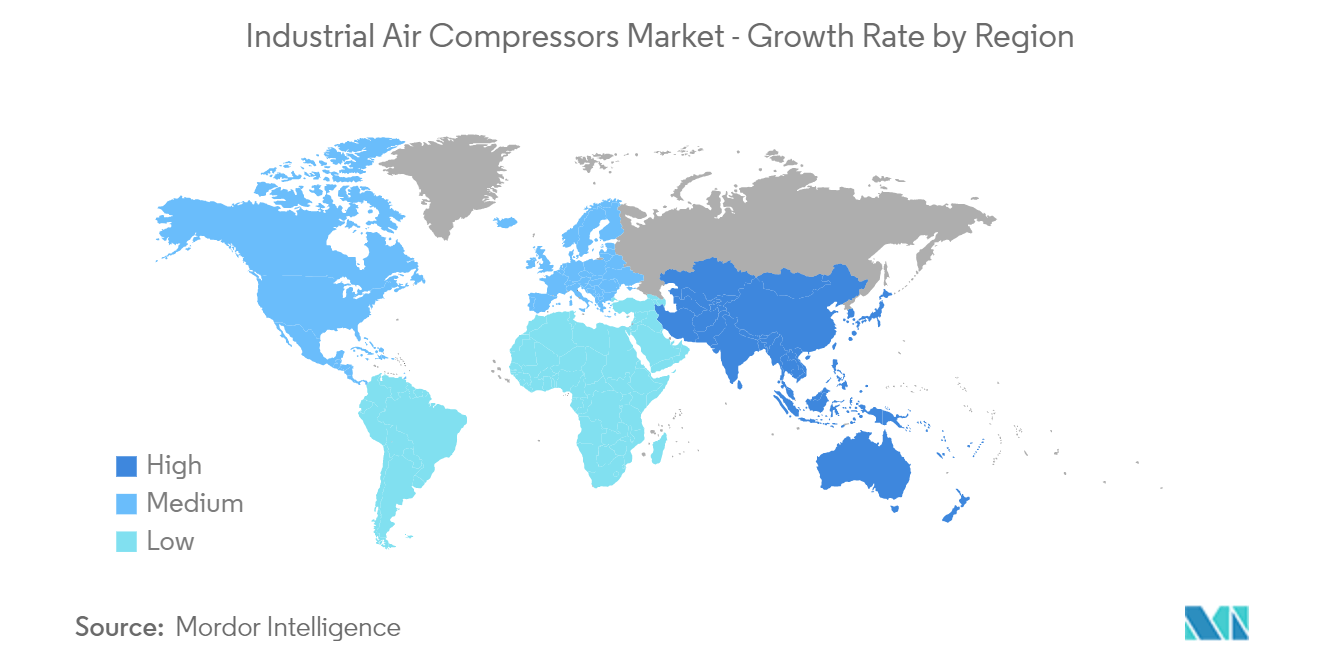
Industrial Air Compressor Industry Overview
The Industrial Air Compressors Market is competitive, with several players in the market. The players in the market, such as Atlas Copco Group, Ingersoll Rand Inc.(Gardner Denver Inc.), Kaeser Kompressoren, Inc., and Mitsubishi Heavy Industries Compressor Corp, are engaged in maintaining a competitive edge in the market. This has intensified the competitive rivalry in the market, and therefore, the market concentration is low.
In May 2022, ELGi introduced two new ranges of Air Compressors, ELGi AB 11 - 22kW, the latest addition to the AB-Series range of oil-free screw air compressors. The units specifically address the compressed air requirements of the food and beverage, small pharmaceutical, and dairy industry, and LD Series 2.2 - 11kW lubricated direct drive range of reciprocating air compressors. The new LD Series is an innovation in piston air compressor technology.
In June 2022, Ingersoll Rand unveiled the latest innovation in its centrifugal portfolio, the new MSG Turbo-Air NX 1500 (NX 1500) compressor, engineered to deliver the lowest total cost of ownership for sites seeking a long-lasting, low-maintenance and 100 percent oil-free solution. The NX 1500 can meet the demands of energy-intensive sites while making a substantial difference to a business's bottom line through a range of proven technologies and features.
Industrial Air Compressor Market Leaders
-
Atlas Copco AB
-
Ingersoll Rand Inc. (Gardner Denver Inc.)
-
Mitsubishi Heavy Industries Compressor Corp
-
Kaeser Kompressoren, Inc.
-
FS-Curtis (Curtis-Toledo, Inc.)
*Disclaimer: Major Players sorted in no particular order
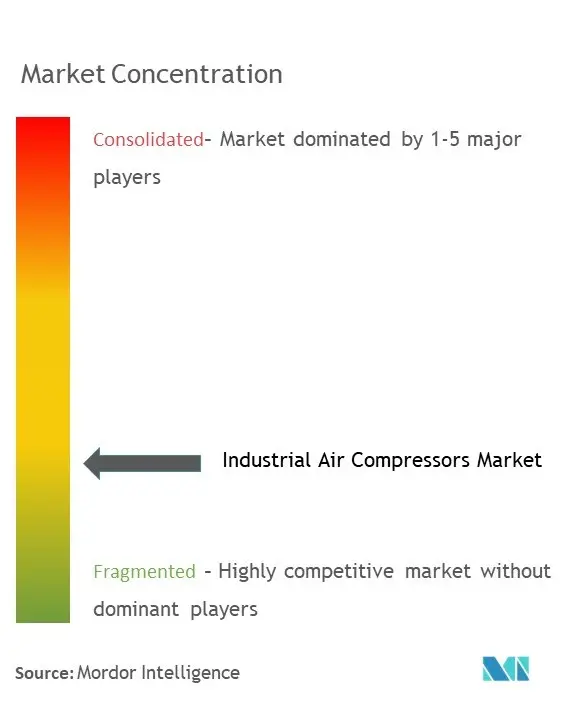
Industrial Air Compressor Market News
- September 2022: Howden announced that it secured a compressor contract for Majnoon oilfield, Iraq. Howden has secured a contract with Azku Global Services, part of the Khudairi Group. Howden will supply two screw compressor packages to Majnoon oilfield, near Basrah, Iraq. Howden's state-of-the-art screw compressor packages will be installed in Majnoon oilfield's flare gas recovery system. The waste gas will be recovered and treated to deliver safe, useable fuel gas, saving energy and minimizing carbon emissions.
- August 2022: Ingersoll Rand Inc. entered into agreements to acquire Holtec Gas Systems LLC, Shanghai Hanye Air Purifying Technology Co., Ltd, and Hydro Prokav Pumps (India) Private Limited for a combined cash purchase price of approximately USD 35 million. Holtec and Hanye aim to expand Ingersoll Rand's air treatment capabilities and enhance the breadth of solutions offered for the larger compressor ecosystem.
- May 2022: Mitsubishi Electric Corporation announced that it would invest 1.44 billion Turkish lire (USD 113 million) in a new plant at Mitsubishi Electric Air Conditioning Systems Manufacturing Turkey Joint Stock Company (MACT), the company's air-conditioner production base in Turkey. The expansion will expand MACT's annual capacity for air-to-water (ATW) heat pumps to 300,000 units, up by 100,000 units from current capacity, and room air conditioners to 1,100,000 units, up by 300,000 units. Production will begin in February 2024.
Industrial Air Compressor Market Report - Table of Contents
1. INTRODUCTION
- 1.1 Study Assumptions and Market Definition
- 1.2 Scope of the Study
2. RESEARCH METHODOLOGY
3. EXECUTIVE SUMMARY
4. MARKET INSIGHTS
- 4.1 Market Overview
- 4.2 Industry Value Chain Analysis
-
4.3 Industry Attractiveness - Porter Five Forces
- 4.3.1 Bargaining Power of Suppliers
- 4.3.2 Bargaining Power of Consumers
- 4.3.3 Threat of New Entrants
- 4.3.4 Intensity of Competitive Rivalry
- 4.3.5 Threat of Substitutes
- 4.4 Impact of COVID-19 on the market
5. MARKET DYNAMICS
-
5.1 Market Drivers
- 5.1.1 Increasing Global Investment in Oil and Gas
- 5.1.2 Demand for Energy Efficient Compressors
-
5.2 Market Restraints
- 5.2.1 Environmental and Safe Use Concerns
6. MARKET SEGMENTATION
-
6.1 By Type
- 6.1.1 Rotary Air Compressors
- 6.1.2 Reciprocating Air Compressors
- 6.1.3 Centrifugal Air Compressors
-
6.2 By End-user
- 6.2.1 Oil and Gas
- 6.2.2 Food and Beverages
- 6.2.3 Manufacturing
- 6.2.4 Healthcare
- 6.2.5 Power Generation
- 6.2.6 Construction and Mining
- 6.2.7 Other End-user Industries
-
6.3 By Geography
- 6.3.1 North America
- 6.3.1.1 United States
- 6.3.1.2 Canada
- 6.3.2 Europe
- 6.3.2.1 United Kingdom
- 6.3.2.2 Germany
- 6.3.2.3 France
- 6.3.2.4 Rest of Europe
- 6.3.3 Asia- Pacific
- 6.3.3.1 China
- 6.3.3.2 Japan
- 6.3.3.3 India
- 6.3.3.4 South Korea
- 6.3.3.5 Rest of Asia-Pacific
- 6.3.4 Latin America
- 6.3.5 Middle East and Africa
7. COMPETITIVE LANDSCAPE
-
7.1 Company Profiles
- 7.1.1 Atlas Copco Group
- 7.1.2 Ingersoll Rand Inc.
- 7.1.3 FS-Curtis
- 7.1.4 Howden Group Ltd.
- 7.1.5 Gardner Denver Inc.
- 7.1.6 Mitsubishi Heavy Industries Compressor Corp.
- 7.1.7 Kaeser Kompressoren
- 7.1.8 Zhejiang Kaishan Compressor Co. Ltd (Kaishan Group)
- 7.1.9 Sullair, LLC (Hitachi Group)
- 7.1.10 Bauer Kompressoren GmbH
- 7.1.11 Aerzener Maschinenfabrik GmbH
- 7.1.12 Hanwha Power Systems
- *List Not Exhaustive
8. INVESTMENT ANALYSIS
9. MARKET OPPORTUNITIES AND FUTURE TRENDS
** Subject To AvailablityIndustrial Air Compressor Industry Segmentation
An industrial air compressor is a device that uses an electric motor to convert power into potential energy in compressed air form, which is then forced to the storage tanks by these compressors. Depending upon the desired pressure, these can be done in a single-stage or multiple stages. The compressed air is then used in various industries by utilizing the kinetic energy of the air when released.
The Industrial Air Compressors Market is segmented by Type (Rotary Air Compressors, Reciprocating Air Compressors, and Centrifugal Air Compressors), End-user Industry (Oil & Gas, Food & Beverages, Manufacturing, Healthcare, Power Generation, Construction & Mining), and Geography (North America, Europe, Asia Pacific, Latin America, MEA). The market sizes and forecasts are provided in terms of value (USD million) for all the above segments.
| By Type | Rotary Air Compressors | |
| Reciprocating Air Compressors | ||
| Centrifugal Air Compressors | ||
| By End-user | Oil and Gas | |
| Food and Beverages | ||
| Manufacturing | ||
| Healthcare | ||
| Power Generation | ||
| Construction and Mining | ||
| Other End-user Industries | ||
| By Geography | North America | United States |
| Canada | ||
| By Geography | Europe | United Kingdom |
| Germany | ||
| France | ||
| Rest of Europe | ||
| By Geography | Asia- Pacific | China |
| Japan | ||
| India | ||
| South Korea | ||
| Rest of Asia-Pacific | ||
| By Geography | Latin America | |
| Middle East and Africa |
Industrial Air Compressor Market Research FAQs
How big is the Industrial Air Compressors Market?
The Industrial Air Compressors Market size is expected to reach USD 35.62 billion in 2024 and grow at a CAGR of 3.70% to reach USD 42.72 billion by 2029.
What is the current Industrial Air Compressors Market size?
In 2024, the Industrial Air Compressors Market size is expected to reach USD 35.62 billion.
Who are the key players in Industrial Air Compressors Market?
Atlas Copco AB, Ingersoll Rand Inc. (Gardner Denver Inc.), Mitsubishi Heavy Industries Compressor Corp, Kaeser Kompressoren, Inc. and FS-Curtis (Curtis-Toledo, Inc.) are the major companies operating in the Industrial Air Compressors Market.
Which is the fastest growing region in Industrial Air Compressors Market?
Asia Pacific is estimated to grow at the highest CAGR over the forecast period (2024-2029).
Which region has the biggest share in Industrial Air Compressors Market?
In 2024, the Asia Pacific accounts for the largest market share in Industrial Air Compressors Market.
What years does this Industrial Air Compressors Market cover, and what was the market size in 2023?
In 2023, the Industrial Air Compressors Market size was estimated at USD 34.35 billion. The report covers the Industrial Air Compressors Market historical market size for years: 2019, 2020, 2021, 2022 and 2023. The report also forecasts the Industrial Air Compressors Market size for years: 2024, 2025, 2026, 2027, 2028 and 2029.
Industrial Air Compressor Industry Report
Statistics for the 2024 Industrial Air Compressor market share, size and revenue growth rate, created by Mordor Intelligence™ Industry Reports. Industrial Air Compressor analysis includes a market forecast outlook to 2029 and historical overview. Get a sample of this industry analysis as a free report PDF download.



